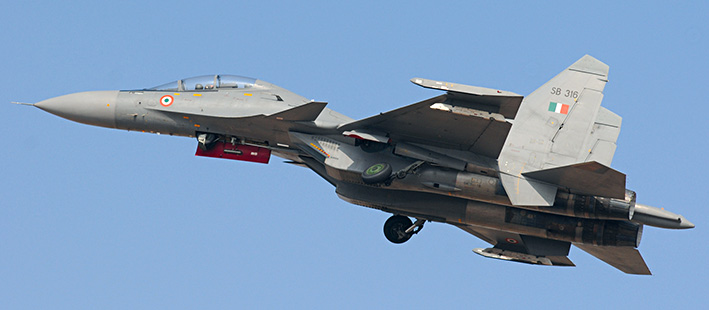|
 On 9 January 2015 Hindustan Aeronautics Ltd. (HAL) officially handed over its 150th Su-30MKI fighter produced under the license programme. It became the 200th aircraft of the type to be fielded with Indian Air Force. On 9 January 2015 Hindustan Aeronautics Ltd. (HAL) officially handed over its 150th Su-30MKI fighter produced under the license programme. It became the 200th aircraft of the type to be fielded with Indian Air Force.
Today, the Su-30MKI twin-seat supermanoeuvrable multirole fighter is the trademark of the Indian Air Force and its most advanced combat plane in service. To date, the Russia's Irkut corporation has supplied IAF with 50 fly-away aircraft of the type and India's HAL has been licence-producing the Su-30MKI since 2004.
Irkut delivered the first 32 Su-30MKIs under the 1996 contract to IAF during 2002-2004. Later on, 18 more fighters of the type arrived in 2008-2009 under a "trade-in" deal clinched in 2007 as a replacement of 18 Su-30Ks delivered in late 1990s.
The contract with India on licence production of 140 Sukhoi Su-30MKIs, AL-31FP thrust vector control engines and avionics, including the Tikhomirov-NIIP Bars phased-array radars, was signed on 28 December 2000. It became the major deal in the Russian-Indian cooperation, valued at $3 billion-plus. The first HAL-assembled Su-30MKI was accepted by IAF on 28 November 2004.
In 2007, Rosoboronexport and Irkut, on the one hand, and the Indian Ministry of Defence and HAL, on the other, struck a deal for 40 Su-30MKI knockdown kits more, with Irkut having completed the deliveries under the contract during 2008-2010.
On 24 December 2012, during Russian President Vladimir Putin's visit to India, one more contract, for delivery of 42 Su-30MKI multirole supermanoeuvrable fighter knockdown kits to India, was signed. According to the Indian press, the deal's worth is estimated at about $1.6 billion.
HAL Chairman R.K. Tyagi said in December 2012 that after 42 more knockdown kits had been ordered, HAL's licence-produced Su-30MKI output would total 222 aircraft. Thus, considering the ready-made Su-30MKIs delivered by Irkut, IAF will have a fleet of 272 aircraft of the type in the end.
According to an official HAL news release, the Russian-Indian Su-30MKI licence production programme involves 157 Indian subcontractors. HAL's MiG Complex in Nasik handles the manufacture of Su-30MKI airframes and the final assembly of the planes. The manufacture of AL-31FP engines with the use of UMPO-supplied components is performed by HAL's plant in Koraput. The communication gear and navigation systems are made in Hyderabad, while the hydraulic, pneumatic and fuel units in Lucknow and cockpit MFDs and satnav systems in Korwa.
Meanwhile, the Su-30MKI programme has not been sitting on its hands, and the fighter being delivered to India these days differ from those supplied earlier in the decade in greater capabilities of the fire control system owing to latest operating modes and enhanced characteristics of the avionics suite. Since the Su-30MKI production and deliveries will have continued for at least four to five years more while their service life will last at least 25 years, further improvement of the aircraft by means of even more sophisticated avionics and weapons comes to the fore. Such priorities now include the arming of the Indian Su-30MKI fleet with the cutting-edge BrahMos-A long-range precision-guided multirole air-to-surface missiles that is under development by BrahMos Russian-Indian joint venture, which has already delivered missile's ship-based and land-based versions to the Indian Navy and Army. The first BrahMos-A test launch from Indian Su-30MKI is to take place in March 2015.
In addition, the upgrade will apply to the fighter's avionics suite. The current preliminary agreements stipulate phased upgrade of the Tikhomirov-NIIP's Bars phased-array radar. The first phase of the upgrade is supposed to boost the radar's performance through introduction of additional operating modes as well as more-capable computers and software. This is to maximise the reliance on the solutions of the existing phased-array radar already productionised by India under Russian license. Phase two of the upgrade is to see the Bars's passive phased array replaced with an active electronically-scanned array (AESA).
(Photo: Simon Watson)
|
